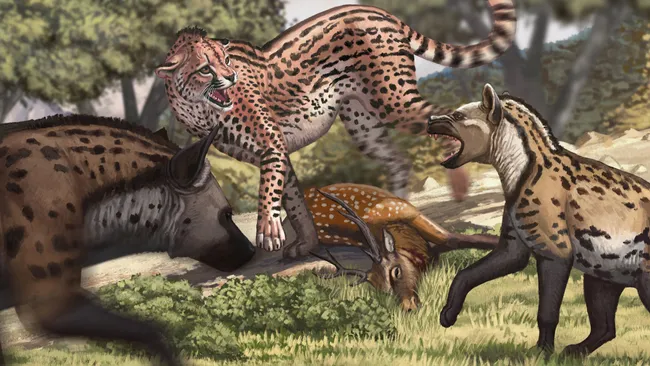Scientists have unveiled the world’s largest-ever cheetah species, the extinct colossal cat Acinonyx pleistocaenicus, after scrutinizing fossils of its massive skull. This behemoth predator rivaled the size of today’s largest cats and dwarfed modern cheetahs by more than threefold.
Acinonyx pleistocaenicus once roamed Eurasia from approximately 1.3 million to 500,000 years ago. It was initially described in 1925, based on a partial lower jawbone discovered in Shanxi Province, northern China.
In this recent study, researchers examined these fossils alongside more recently unearthed remains from China. By analyzing the length of the skull, height of the molar tooth, and width of the bony structure connecting the skull and spine, they estimated the creature’s weight. Their findings suggest that A. pleistocaenicus weighed over 290 pounds (130 kilograms) and could have reached a staggering 420 pounds (190 kg) — comparable in size and weight to a modern-day tiger or lion. This made it significantly heavier than today’s African cheetahs, which typically weigh between 75 to 140 pounds (34 to 64 kilograms).
The newly studied fossils, including two mandibles recovered in 2021 from Jinyuan Cave in Liaoning Province and part of a cranium from the Zhoukoudian Cave system in Beijing, date back to around 780,000 years ago, during the Pleistocene period.
Distinctive features such as a high, thick-walled skull and an unusually wide snout helped identify these fossils as belonging to A. pleistocaenicus. Interestingly, the extinct giant cheetahs shared remarkable similarities with modern African cheetahs, including tooth arrangement and nasal structure.
Published in the May 15 edition of Quaternary Science Reviews, the study also suggests that A. pleistocaenicus went extinct around 500,000 years ago, possibly due to climate change during the Mid-Pleistocene Transition. This transition saw Earth shift from ice ages cycling every 41,000 years to longer, more intense ice ages occurring every 100,000 years.
At one of the excavation sites, researchers also identified another extinct cheetah species, A. intermedius, indicating that A. pleistocaenicus was likely replaced by smaller cheetah species.
“We hope our study can provide more insights into the evolution and dispersal of the cheetah, showcasing the past success of this remarkable lineage of cats in Eurasia,” commented Qigao Jiangzuo, a paleontologist at the Chinese Academy of Sciences in Beijing.
